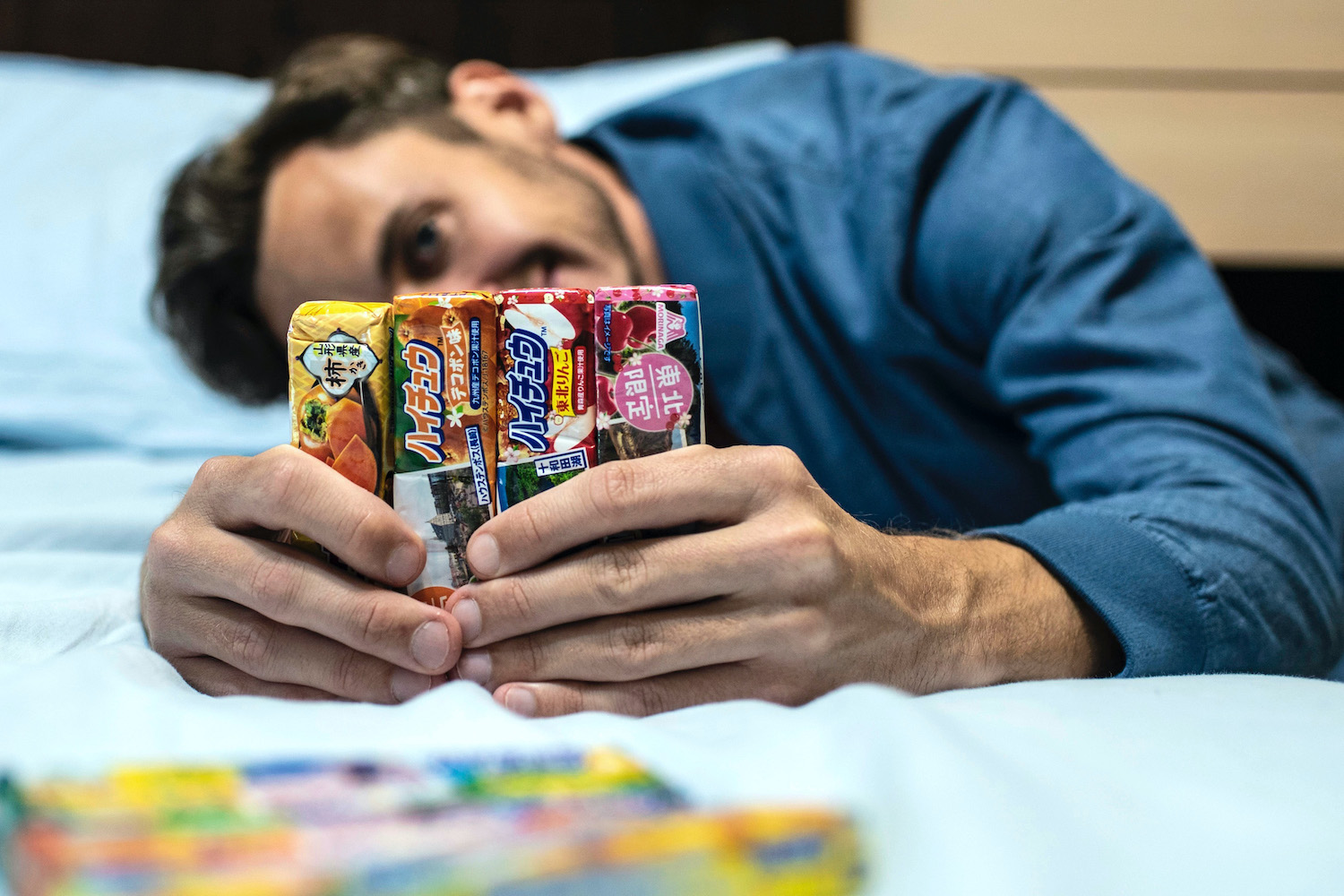I’ve been planning a post about Japanese Hi-Chew flavors for a long time, but I kept getting sidetracked. This was first and foremost because I always acquire additional packs of the sticky-sweet snack with each trip to Japan. The longer I waited, the more unfeasible it seemed that I’d be able to condense my huge haul into a single article.
Now, of course, as the world shuts down due to coronavirus, I have a lot more time to go through my candy drawers. (Message to the future: I hope the crisis is over know—Japan is where to buy Hi-Chew, at least the ones on this list, so you’ll need to be able to get there if you want to taste them!)
Whether you’re a Hi-Chew candy expert or have never tasted it, you’re going to find the next few paragraphs delicious. Certainly, I didn’t realize how meticulous I’d been in collecting the stuff over the years!
The History of Hi-Chew (Inside and Outside of Japan)
Hi-Chew has existed in some form since 1975, although the current packages of Hi-Chew flavors emerged much more recently. In fact, it was only in 1996 that individually-wrapped Hi-Chew began being sold; prior to that, it was sold as a single stick you took bites off. Eew! At any rate, I find interesting the logic the Morinaga corporation used in having developed the candy in the first place: Essentially, Hi-Chew is meant to be gum you can swallow.
These days, Hi-Chew is found in many countries throughout the world, from places in Asia like China, Taiwan and Thailand, to Western countries from the US and Canada to several places in Europe. Although the flavors and packaging are different in different places, the basic of idea of the candy, as well as its composition (Hi-Chew calories are the same anywhere on the planet!) are uniform.
Weird Hi-Chew Flavors from My Japan Travels
Apple Hi-Chew from Aomori
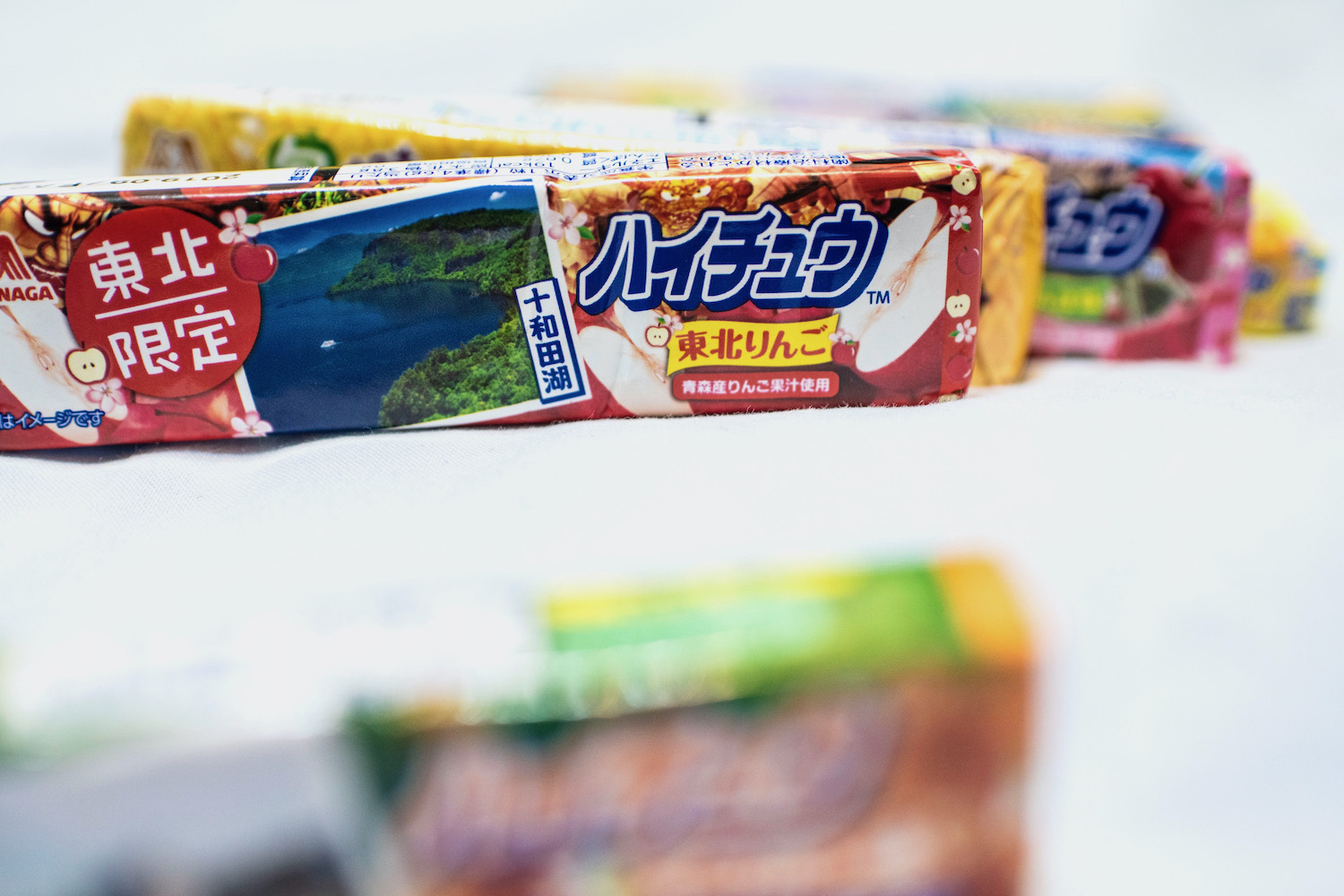
Basically every country has Hi-Chew strawberry, but very few can claim to have an apple flavor. This is even true for most of Japan, apart from Aomori prefecture in the Tohoku region. If you’ve ever been to Honshu’s northernmost city, of course, you’ll realize why this is the case. Aomori produces more apples than anywhere else in Japan—make sure to visit the A-House shop and cider hall the next time you’re in town!
Dekopon Hi-Chew from Kyushu
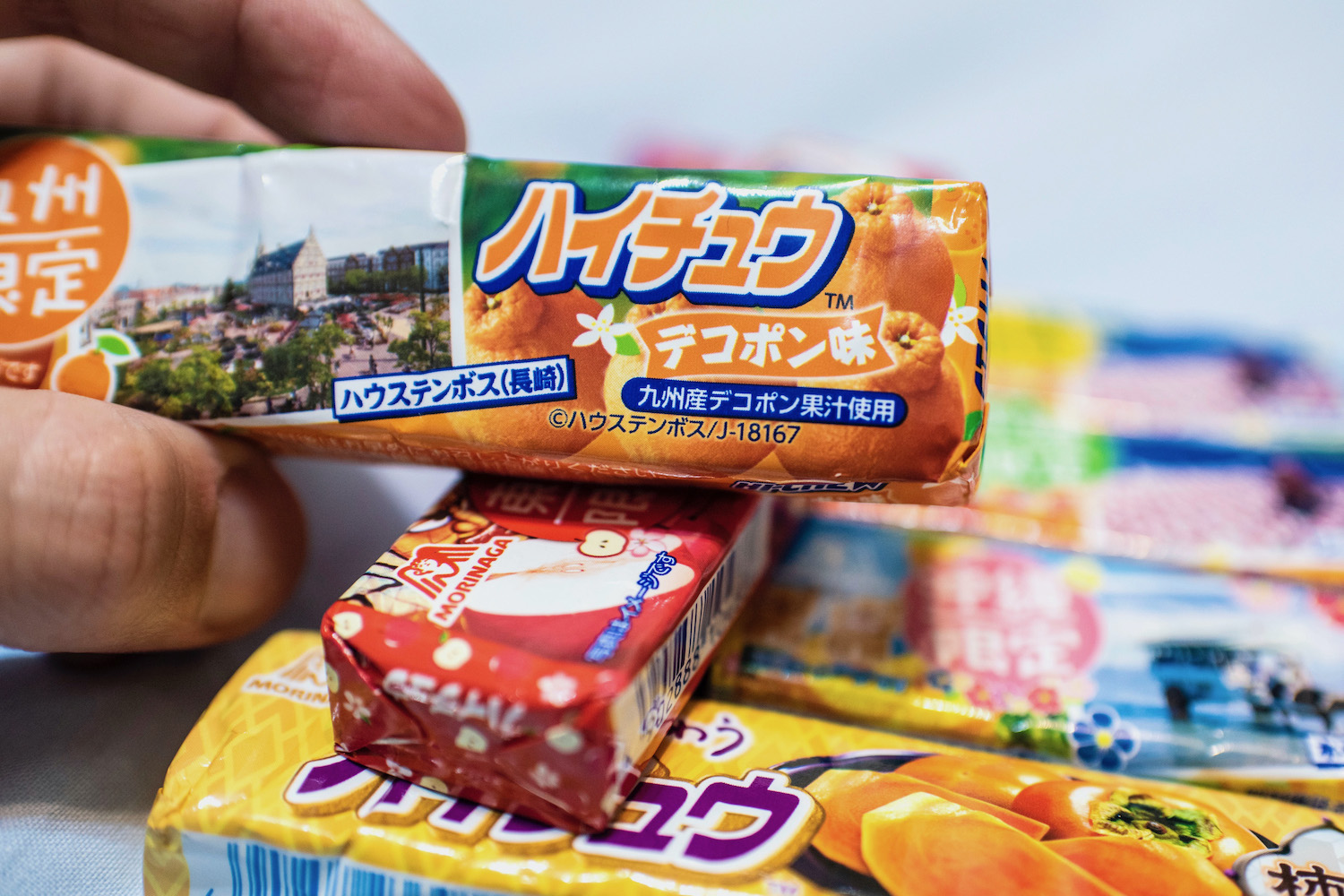
Next up on the Hi-Chew flavors list is one you probably won’t recognize—I know I didn’t; I had to double-check the katakana! To be sure, I have never in my 35 years speaking English used the work “Dekopon.” However, this orange-like fruit (which I’ve always just called an orange) is ubiquitous throughout Kyushu; I bought this particular pack at a gift shop just beneath Kumamoto Castle.
Persimmon Hi-Chew for Autumn

If you’ve ever traveled in Japan in autumn, you’ll know that persimmons are a sign of the season, whether you buy fresh and juicy ones in city markets, or visit the countryside and see them strung out to dry. As a result, persimmon is probably the most seasonal of Hi-Chew flavors, and is also one of the most special for me as a result. That, and because persimmon (kaki) is probably my favorite Japanese fruit. I always pick up a pack or two of these whenever I see them!
Sakura Hi-Chew from Yamagata
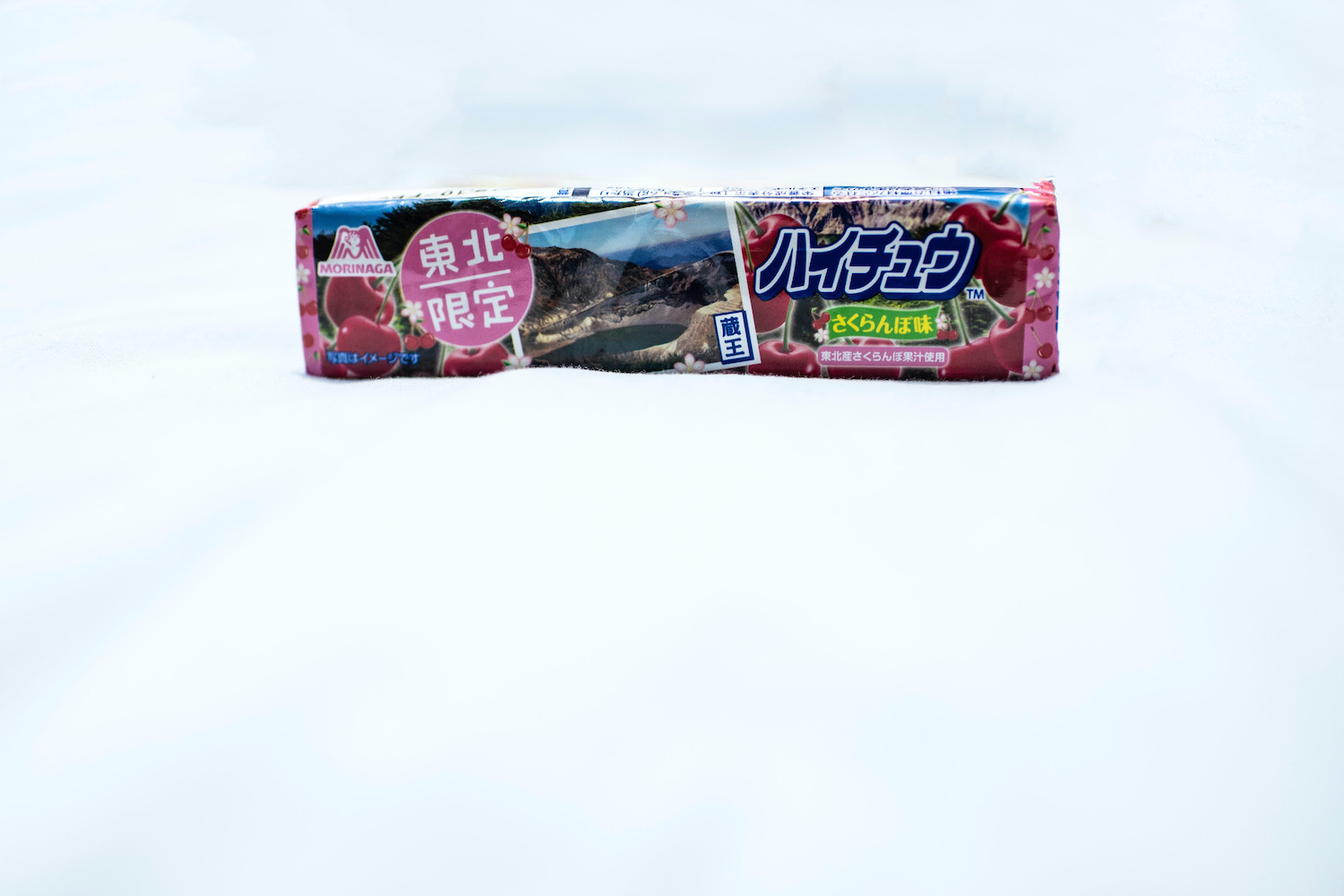
One flavor of Hi-Chew Japanese candy that is both seasonal and regional is the sakura variety I picked up in Yamagata a couple of years ago. Actually, I’m not sure if it’s seasonal. Although it’s adorned with cartoon cherry blossoms, I actually picked it up in the dead of winter, when I was in Zao Onsen to photograph the snow monsters. At any rate, it’s a beautiful and delicious treat, no matter when you eat it!
A Trio of Special Okinawa Hi-Chew
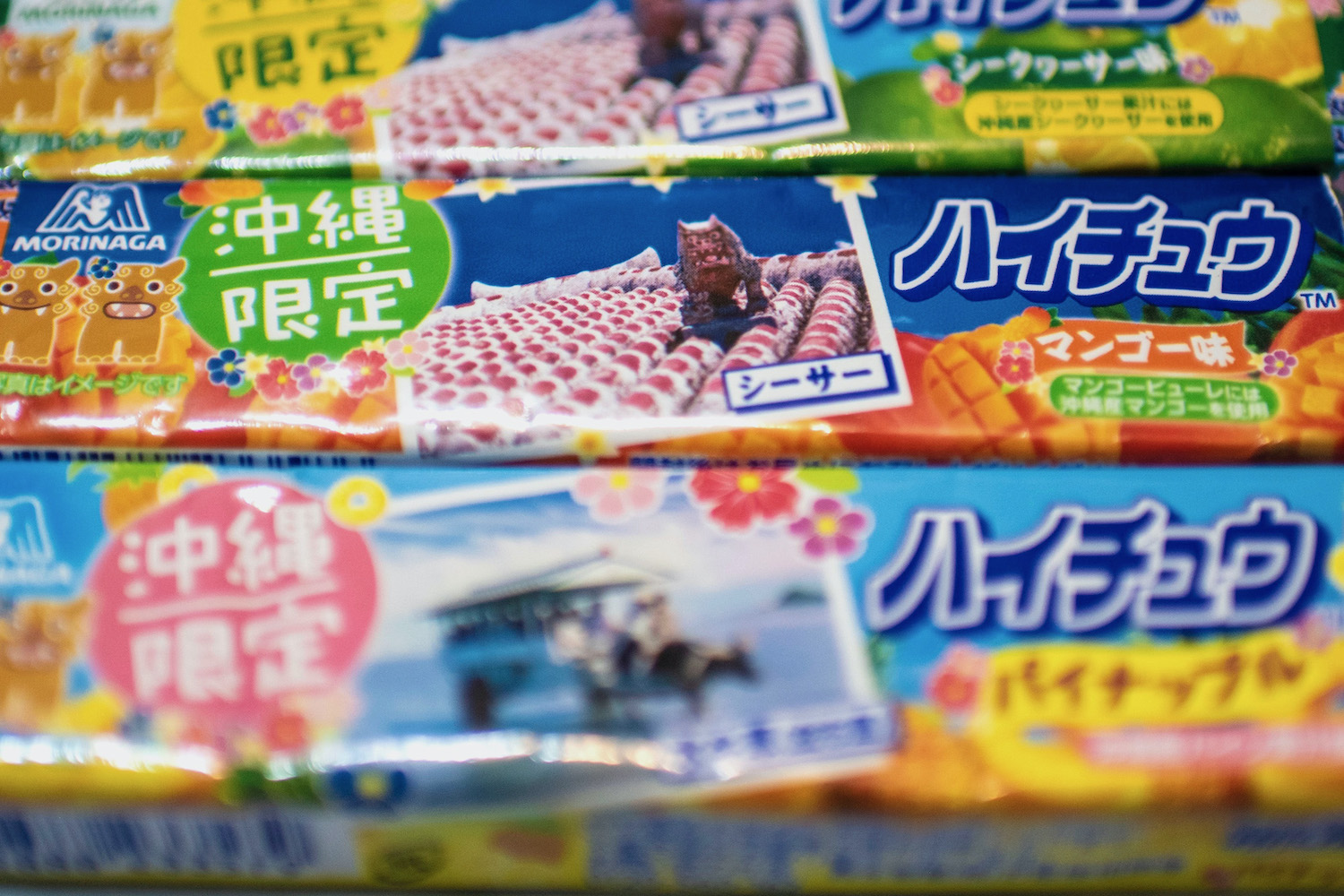
As I alluded to in the introduction to this piece, I don’t plan to run through all Hi-Chew flavors here. As a result, I’ll be ending my list (for now) with a trio of special Okinawa flavors I picked up the last time I was in the Okinawa archipelago: Mango, pineapple and kabosu, a tangerine that’s green on the outside and orange on the inside. As far as I can tell these are not seasonal, so be sure and pick them up the next time you visit Okinawa!
Hi-Chew Flavors I Still Need to Find
I have to be honest: When it comes to finding Hi-Chew Japanese flavors, I like the element of surprise. I’ve tried not to Google too much (and thus, to anticipate too much) about available Hi-Chews. Rather, I’m always on the lookout in certain cities and regions, be this at 7-11 and other convenience stores, or at the local tourism offices where I’ve made other Hi-Chew discoveries in the past.
Some places haven’t had special Hi-Chew, even though I expected them. For instance in Tottori, a famous producer of pears, I couldn’t seem to find a Nashi flavor. Likewise, I was surprised that Shikoku doesn’t have its own citrus flavor as Kyushu (which also produces a lot of orange-adjacent fruits) does, and that there wasn’t a loquat flavor Hi-Chew in Nagasaki, given how ubiquitous that fruit seems to be in the city.
Other Amazing Japanese Candy Creations
Let’s take a pause from different Hi-Chew flavors to appreciate the world of Japanese candy, shall we? Now, while I generally frown upon blogger that fixated too much on ordinary aspects of Japanese daily life like convenience stores, a trip through the candy section of one is indeed an amazing experience. From LOTTE chocolate-covered almonds and macadamias, to Melty Kiss treats (which taste exactly how they sound), Japan is a country where you’ll be glad you walk several kilometers per day.
This is to say nothing of all the amazing Japanese Kit-Kat flavors, from well-known ones like matcha and sakura cherry, to less-known varieties that are obscure outside of Japan. I’m mostly thinking of the strange sake one, which doesn’t particularly taste like Nihon-shu, although I do find the packaging oddly soothing. I guess at some point I’m going to need to do a post about Kit Kats in Japan as well!
FAQ About Hi-Chew Flavors
What is the best Hi-Chew flavor?
Although I love many of the “special” Hi-Chew flavors I’ve featured in this article, I think most people would agree that “classic” flavors like strawberry and grape are the best Hi-Chew flavors.
Are Hi-Chews bad for you?
If you can limit yourself to a single Hi-Chew, each of which has about 3 grams of sugar and 21 calories, you could make the argument that Hi-Chews are not “bad” for you. However, since you are likely to eat the better part of a pack (i.e. 10 pieces), you are looking at a whopping ~30 grams of sugar and 210 calories. Definitely not what I would call “healthy”!
Where can I buy Hi-Chew candy?
In Japan (and throughout most of the rest of Asia), you can easily find Hi-Chew at any convenience store, including 7/11, FamilyMart and Lawson. In the United States, Hi-Chew are available at Walmart, Target and many other “big box” type stores, although flavors and packaging differ from what you find in the Far East.
The Bottom Line
I’ve got to admit: Even if I was surprised by the wide range of Hi-Chew flavors I’ve accumulated over the years! From the regional taste of Okinawa and Kyushu, to seasonal candy from the Aomori and Yamagata prefectures of Tohoku, Hi-Chew is much more than the quotidian varieties you find at your local 7-11 (or Family Mart or Lawson—wherever you find it). If you’ve found interesting Hi-Chew during your own trips to Japan, I hope you’ll leave a comment and tell me all about them. And if you want to plan a truly unique trip to Japan, irrespective of your affinity for Hi-Chew, consider commissioning a custom Japan itinerary today!



